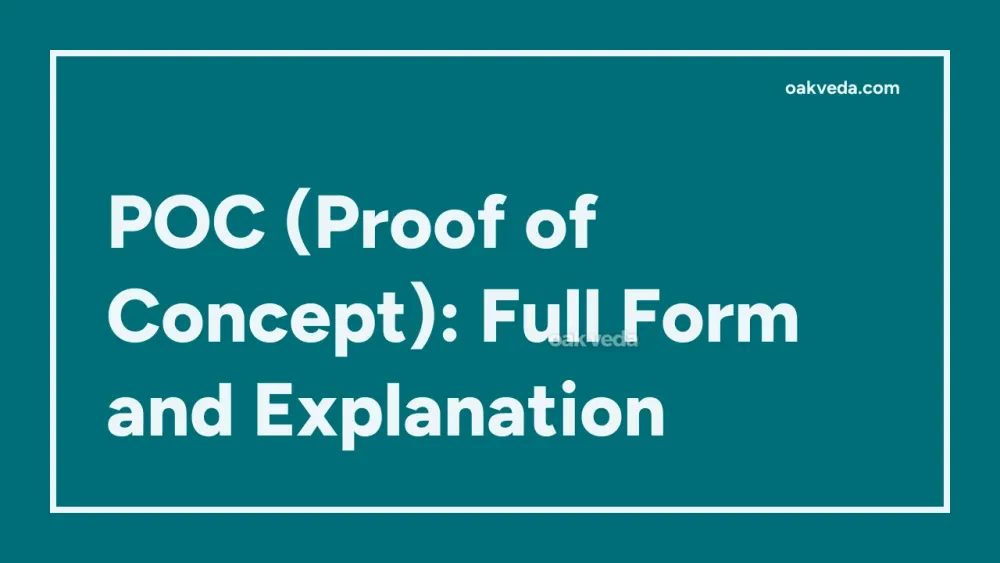
What is the Full Form of POC?
The full form of POC is Proof of Concept. This term is widely used in various industries, particularly in technology, business, and project management. POC serves as a crucial step in the development process, helping organizations validate ideas and assess their feasibility before committing significant resources to full-scale implementation.
What is Proof of Concept?
Proof of Concept is a demonstration or small-scale project that aims to verify the practical potential of a concept, theory, or idea. It's designed to show that a proposed solution is viable and can be implemented in real-world scenarios. A POC is typically conducted in the early stages of project development to evaluate the feasibility and potential value of an idea before investing substantial time and resources.
Origin and Development of Proof of Concept
The concept of POC has been around for decades, but its importance has grown significantly with the rapid advancement of technology and the increasing complexity of business projects. Originally used in engineering and scientific research, POC has evolved to become a standard practice in various fields, including software development, product design, and business strategy.
How does Proof of Concept work?
A Proof of Concept typically follows these steps:
- Idea Generation: A concept or solution is proposed to address a specific problem or opportunity.
- Planning: A small-scale project is designed to test the core aspects of the idea.
- Implementation: The POC is executed, often in a controlled environment.
- Evaluation: Results are analyzed to determine the concept's feasibility and potential.
- Decision Making: Based on the POC outcomes, stakeholders decide whether to proceed with full-scale development or explore alternative solutions.
Types of Proof of Concept
While the general principle remains the same, POCs can vary depending on the industry and specific needs:
- Technical POC: Focuses on validating the technical feasibility of a solution.
- Business POC: Aims to verify the business viability and potential return on investment.
- Functional POC: Demonstrates the core functionalities of a proposed system or product.
- Integration POC: Tests the compatibility of a new solution with existing systems.
Functions of Proof of Concept
The primary functions of a POC include:
- Validating the feasibility of an idea or concept
- Identifying potential technical and operational challenges
- Providing a basis for estimating resources required for full implementation
- Helping stakeholders make informed decisions about project continuation
- Gathering early feedback to refine and improve the proposed solution
Applications of Proof of Concept
POCs are widely used across various industries and scenarios:
- Software Development: Testing new technologies or architectures
- Product Design: Validating new product ideas before full-scale production
- Business Strategy: Evaluating new business models or market entry strategies
- Scientific Research: Demonstrating the potential of new theories or methodologies
- Manufacturing: Testing new production processes or materials
Features of Proof of Concept
Key features of an effective POC include:
- Limited Scope: Focuses on core functionalities or critical aspects of the idea
- Time-Bound: Typically completed within a short timeframe
- Cost-Effective: Requires minimal resources compared to full implementation
- Measurable: Produces tangible results that can be evaluated objectively
- Flexible: Allows for adjustments and improvements based on feedback
Benefits of Proof of Concept
Implementing a POC offers several advantages:
- Risk Mitigation: Identifies potential issues early in the development process
- Resource Optimization: Prevents wastage of resources on unfeasible projects
- Stakeholder Buy-In: Provides tangible evidence to convince stakeholders
- Improved Planning: Offers insights for more accurate project scoping and estimation
- Innovation Catalyst: Encourages experimentation with new ideas and technologies
Limitations or Challenges of Proof of Concept
While POCs are valuable, they have some limitations:
- Limited Scope: May not capture all aspects of full-scale implementation
- Controlled Environment: Results may differ in real-world scenarios
- Time Pressure: Short timelines may lead to oversimplification
- False Positives/Negatives: Success or failure in POC doesn't guarantee the same in full implementation
- Resource Allocation: Balancing resources between POC and other projects can be challenging
Future Developments in Proof of Concept Technology
As technology evolves, so does the approach to POCs:
- AI-Driven POCs: Leveraging artificial intelligence to automate and enhance POC processes
- Virtual and Augmented Reality: Using immersive technologies for more realistic POC simulations
- Rapid Prototyping: Integrating advanced 3D printing and modeling techniques for faster POC development
- Cloud-Based POCs: Utilizing cloud platforms for more scalable and accessible POC environments
- Collaborative POCs: Implementing tools for better stakeholder involvement and real-time feedback
FAQs on POC Full Form
-
What's the difference between a POC and a prototype? A POC focuses on validating the feasibility of an idea, while a prototype is a working model of the proposed solution.
-
How long does a typical POC take? POC duration varies but usually ranges from a few weeks to a few months, depending on the complexity of the concept.
-
Is a POC always necessary? While not always mandatory, a POC is highly recommended for complex, innovative, or high-risk projects.
-
Can a failed POC be valuable? Yes, a failed POC can provide valuable insights, helping to identify issues early and save resources in the long run.
-
How detailed should a POC be? A POC should be detailed enough to validate the core concept but not so complex that it becomes a full-scale project.
By understanding the full form and importance of POC (Proof of Concept), organizations can make more informed decisions, mitigate risks, and increase the likelihood of successful project outcomes.
You may be interested in:

